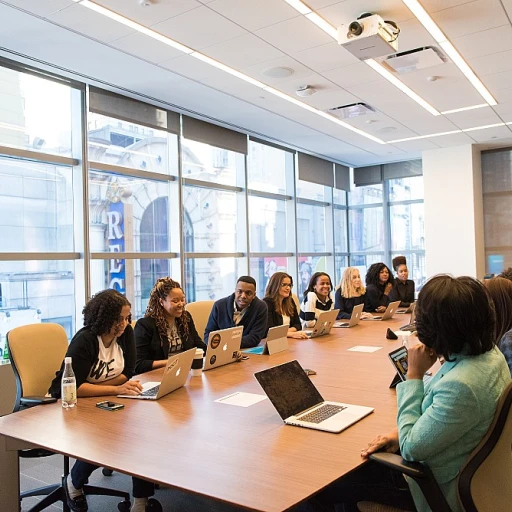
Understanding the Essence of Continuous Innovation
Grasping the Core Principle of Innovation
Continuous innovation is more than just the latest buzzword in modern management strategies—it’s a vital component for sustained success in today's competitive marketplace. It involves not only the generation of novel ideas but also the implementation of these ideas into workable solutions that enhance organization potential and customer satisfaction. To truly embrace this concept, an enterprise must consistently adapt, evolve, and reinvent itself, infusing innovation at every level of its operations. A deeper understanding of continuous innovation begins with recognizing its significance in maintaining competitive advantage. Leveraging technology, such as 3D printing, unveils new supply chain approaches for the general manager that can streamline operations, reduce costs, and improve product quality. These technological advancements keep firms ahead of the curve, offering opportunities to explore new markets and meet evolving customer needs. Continuous innovation isn’t about occasional, blockbuster changes—rather, it’s an ongoing process of smaller, incremental improvements that collectively yield significant advances over time. This requires an organizational culture that supports creativity and risk-taking, as well as mechanisms to capture and implement innovative ideas efficiently. For general managers striving to facilitate this environment, it’s paramount to ensure that all members of their teams understand and are aligned with the objectives of innovation efforts. The subsequent sections will delve into the pivotal role leadership plays in fostering innovation and unravel strategies to effectively implement a continuous mode of innovation, addressing potential roadblocks along the way.The Role of Leadership in Fostering Innovation
Cultivating a Culture that Encourages Innovation
For any organization aspiring to sustain continuous innovation, leadership must play an instrumental role in fostering an environment where fresh ideas can thrive. As the primary architects of this culture, general managers carry the responsibility of encouraging innovative thinking across all levels of the organization. Creating an atmosphere that supports creativity involves a few key actions:- Open Communication Channels: By implementing systems that allow team members to share ideas freely, managers can ensure that valuable insights are not lost. Regular brainstorming sessions and feedback loops enable a flow of information that is vital for innovation.
- Encourage Experimentation: Providing teams with the freedom to experiment and take calculated risks can lead to breakthroughs. By supporting trial-and-error methods, leadership can help uncover opportunities for the organization to advance.
- Empowerment Through Resources: Equip employees with the necessary tools and technologies, such as 3D printing, to explore new possibilities and optimize supply chain management. For more insights into integrating such technologies, explore new supply chain approaches here: 3D Printing Supply Chain Approaches.
- Recognition and Incentives: Celebrating successes and acknowledging contributions can motivate teams to continuously push the envelope in innovation.
Strategies for Implementing Continuous Innovation
Implementing Strategies for Sustained Innovation
For general managers striving to maintain a competitive edge, implementing continuous innovation requires a strategic mindset and a firm grasp of underlying principles. Embracing continuous innovation helps organizations respond to dynamic market demands and emerging technologies, an essential aspect for long-term sustainability.
To effectively implement continuous innovation, consider the following strategies:
- Cultivate a Culture of Innovation: Encourage employees at all levels to contribute fresh ideas and solutions. This can be achieved by promoting an open communication environment where experimentation is respected and valued.
- Leverage Cross-functional Collaboration: By enabling teams from various departments to work together, organizations can harness diverse perspectives, leading to more innovative solutions.
- Invest in Emerging Technologies: Staying at the forefront of technology trends allows businesses to integrate advanced solutions that drive innovation further, whether it’s through AI, IoT, or big data analytics.
- Encourage Continuous Learning: Offer professional development opportunities, training sessions, and workshops that help employees acquire new skills and knowledge that fuel innovative thinking.
- Promote Agile Methodologies: Agile frameworks support iterative development and adaptation, essential components for maintaining innovation momentum. Encourage short cycles of development and rapid prototyping to drive iterative improvement.
By integrating these strategies into the organizational framework, general managers can create a sustainable environment that not only supports innovation but propels the company toward transformative success. For a deeper dive into effective management strategies that can support such dynamic environments, consider crafting an effective management incentive plan to reinforce these innovative practices.
Overcoming Challenges in Continuous Innovation
Identifying Typical Obstacles and Breaking Through Barriers
Navigating the path of continuous innovation is fraught with challenges, which can stem from both internal organizational structures and external market dynamics. Understanding the essence of continuous innovation sets the stage for anticipating and overcoming these hurdles effectively.Resistance to Change
One of the primary barriers is resistance to change. This is often ingrained in the corporate culture, where employees and management alike might be comfortable with the status quo. Overcoming this resistance requires strong, visionary leadership that clearly communicates the benefits of continuous innovation, aligns it with the company’s goals, and encourages a culture of experimentation and learning.Resource Allocation
Allocating resources effectively is another critical challenge. Innovation demands not only financial investment but also time and human resources. Leaders must prioritize innovation by aligning resources with strategic objectives and ensuring that teams have access to the necessary tools and technologies.Managing Risks
Innovation inherently involves risk. Successful leaders learn to manage these risks through informed decision-making processes. By fostering an environment where calculated risks are encouraged and failures are seen as learning opportunities, a culture supporting continuous improvement is cultivated.Ensuring Cross-Functional Collaboration
Continuous innovation often requires cross-functional collaboration. Silos within organizations can hinder the flow of ideas and information, stalling innovative efforts. Leaders must break down these silos by promoting open communication and collaboration across departments. This may involve restructuring teams and redefining roles to ensure that everyone is aligned towards common innovation goals.Adapting to Rapid Market Changes
The rapid pace of market changes poses another challenge. Businesses must stay agile to respond quickly to shifting consumer demands and technological advancements. This requires an adaptive leadership approach that continuously monitors market trends, adapts strategies, and remains flexible to pivot when necessary. By understanding these common challenges and how to address them, general managers can effectively implement continuous innovation as a central strategic pillar, fostering a culture of growth and enduring success.Case Studies: Successful Continuous Innovation in Action
Real-World Examples of Continuous Innovation
In the dynamic landscape of business, continuous innovation is not just a buzzword but a crucial strategy for staying relevant. Organizations that have successfully integrated continuous innovation into their core strategy demonstrate how incremental improvements and radical changes can coexist to drive success.
Tech Industry: Embracing Digital Transformation
One of the most illustrative examples comes from the tech industry, where companies have mastered the art of continuous innovation. By constantly updating their existing products and services, these organizations have managed to stay ahead of the market. For instance, the ongoing improvements in software updates and feature enhancements are a testament to their commitment to innovation. This process not only involves the introduction of new ideas but also the refinement of existing ones, ensuring that the customer experience is always at the forefront.
Retail Sector: Adapting to Market Changes
In the retail sector, businesses have embraced innovation management to dynamically respond to market changes. By fostering a culture that encourages cross-functional collaboration, these organizations have been able to implement both incremental and disruptive innovations. This approach has allowed them to adapt their services processes to meet evolving customer needs, thereby securing long-term success.
Automotive Industry: Balancing Incremental and Radical Innovation
The automotive industry provides a compelling example of how continuous innovation can be applied to both products and processes. Companies in this sector have successfully balanced incremental improvements with radical innovation, such as the development of electric vehicles. This dual approach has opened new windows of opportunity, allowing them to capture a broader market share while maintaining their existing customer base.
Lessons Learned
These case studies highlight the importance of a well-rounded innovation process. Whether it’s through dynamically continuous changes or more radical shifts, the key is to foster a culture that supports ongoing improvements. By doing so, organizations can not only survive but thrive in an ever-changing business environment.
Measuring the Impact of Continuous Innovation
Evaluating the Outcomes of Innovation Efforts
Measuring the impact of continuous innovation is crucial for general managers aiming to maintain competitiveness in a global market. It involves assessing various metrics to determine the effectiveness and value of innovative activities.- Financial Performance: Innovation should ultimately lead to improved financial outcomes. Key performance indicators such as revenue growth, profit margins, and return on investment can provide quantitative insights into the success of innovation initiatives.
- Market Position: Enhancing a company's market standing is another critical outcome. This can be gauged by tracking changes in market share, customer acquisition rates, and brand reputation. An organization's ability to expand into new markets and adapt to customer preferences reflects successful innovation.
- Organizational Growth: Continuous innovation fosters a culture of growth within a company. Employee engagement, talent attraction, and retention are pivotal aspects to consider. An environment that encourages innovative thinking not only enhances employee satisfaction but also leads to sustainable organizational development.
- Operational Efficiency: Innovation should streamline processes and improve operational efficiency. Managers should observe improvements in production cycles, process optimizations, and cost reductions as indicators of successful innovation.
- Customer Satisfaction: Ultimately, innovation should meet the evolving needs of customers. Customer satisfaction surveys, feedback, and loyalty indices can help measure the impact of innovation efforts on customer experience and loyalty.










-large-teaser.webp)

